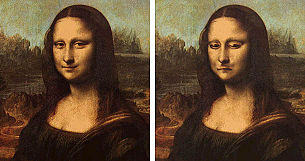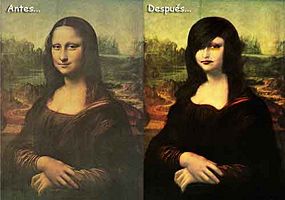| Line 23: | Line 23: | ||
or <math>R2 = \frac{SS_{xy}^2}{SS_{xx} SS_{yy} }</math> ( 2 ) | or <math>R2 = \frac{SS_{xy}^2}{SS_{xx} SS_{yy} }</math> ( 2 ) | ||
| − | with <math>SS_{xy} = \ | + | with <math>SS_{xy} = \sum_{i=1}^N (y_i - y_{avg})(x_i - x_{avg})</math> ( 3 ) |
| + | |||
| + | <math>SS_{yy} = \sum_{i=1}^N (y_i - y_{avg})^2</math> ( 4 ) | ||
| + | |||
| + | <math>SS_{xx} = \sum_{i=1}^N (x_i - x_{avg})^2</math> ( 5 ) | ||
| + | |||
| + | <br> <br> | ||
<br> | <br> | ||
| Line 50: | Line 56: | ||
---- | ---- | ||
| − | [[2011 Fall ECE 438 Boutin|Back to 2011 Fall ECE 438 Boutin]] | + | [[2011 Fall ECE 438 Boutin|Back to 2011 Fall ECE 438 Boutin]] |
[[Category:2011_Fall_ECE_438_Boutin]] | [[Category:2011_Fall_ECE_438_Boutin]] | ||
Revision as of 06:39, 6 December 2011
Similarity analysis of images
Look at the Mona Lisa(s) above. They are very similar, aren't they? It's obvious, and you can say that they have high similarity. But given the pictures below, how to determine the similarity? Let's see!
Introduction & Background
Generally, there are two criteria to determine image similarity, the coefficient of determination (R2) and the mean absolute error (MAE). Here in this project, I use the coefficient of determination for similarity analysis.
The computation of R2 is:
$ R2 = 1 - {\sum_{i=1}^N (y_i - y_{pre})^2 / \sum_{i=1}^N (y_i - y_{avg})^2 } $ ( 1 )
or $ R2 = \frac{SS_{xy}^2}{SS_{xx} SS_{yy} } $ ( 2 )
with $ SS_{xy} = \sum_{i=1}^N (y_i - y_{avg})(x_i - x_{avg}) $ ( 3 )
$ SS_{yy} = \sum_{i=1}^N (y_i - y_{avg})^2 $ ( 4 )
$ SS_{xx} = \sum_{i=1}^N (x_i - x_{avg})^2 $ ( 5 )
...to be continued



